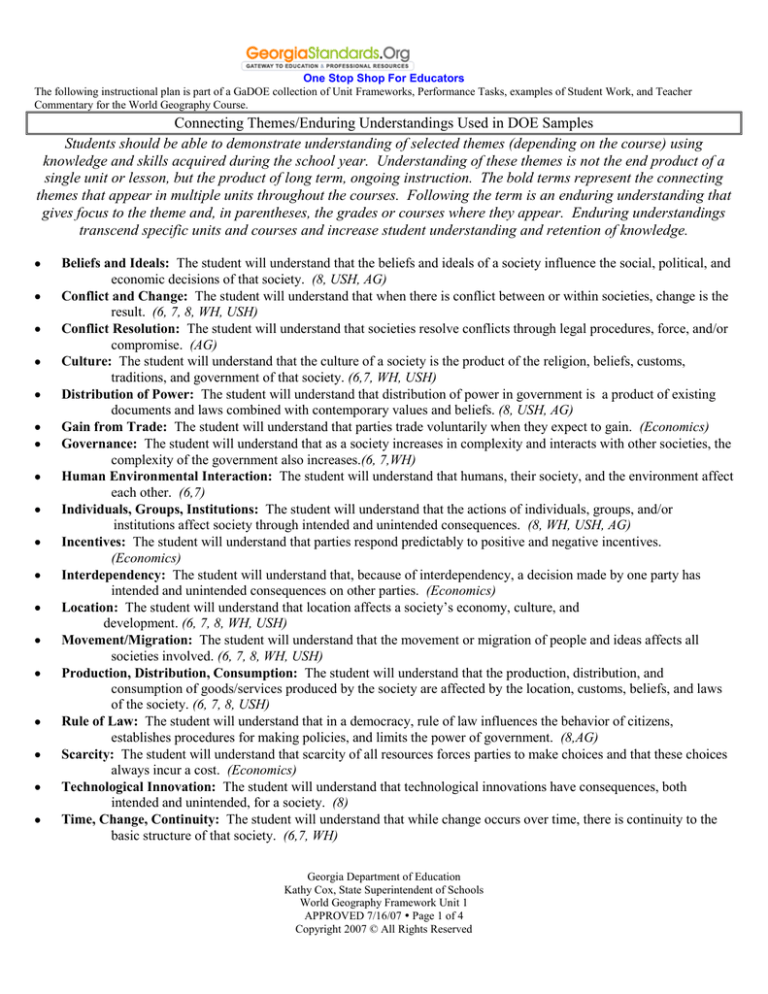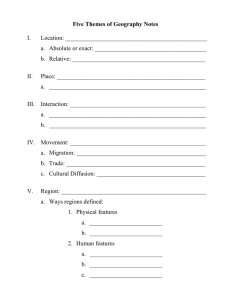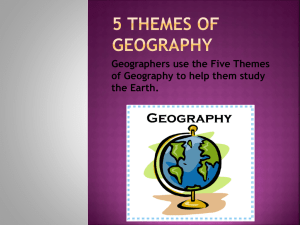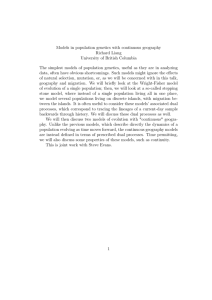
One Stop Shop For Educators
The following instructional plan is part of a GaDOE collection of Unit Frameworks, Performance Tasks, examples of Student Work, and Teacher
Commentary for the World Geography Course.
Connecting Themes/Enduring Understandings Used in DOE Samples
Students should be able to demonstrate understanding of selected themes (depending on the course) using
knowledge and skills acquired during the school year. Understanding of these themes is not the end product of a
single unit or lesson, but the product of long term, ongoing instruction. The bold terms represent the connecting
themes that appear in multiple units throughout the courses. Following the term is an enduring understanding that
gives focus to the theme and, in parentheses, the grades or courses where they appear. Enduring understandings
transcend specific units and courses and increase student understanding and retention of knowledge.
Beliefs and Ideals: The student will understand that the beliefs and ideals of a society influence the social, political, and
economic decisions of that society. (8, USH, AG)
Conflict and Change: The student will understand that when there is conflict between or within societies, change is the
result. (6, 7, 8, WH, USH)
Conflict Resolution: The student will understand that societies resolve conflicts through legal procedures, force, and/or
compromise. (AG)
Culture: The student will understand that the culture of a society is the product of the religion, beliefs, customs,
traditions, and government of that society. (6,7, WH, USH)
Distribution of Power: The student will understand that distribution of power in government is a product of existing
documents and laws combined with contemporary values and beliefs. (8, USH, AG)
Gain from Trade: The student will understand that parties trade voluntarily when they expect to gain. (Economics)
Governance: The student will understand that as a society increases in complexity and interacts with other societies, the
complexity of the government also increases.(6, 7,WH)
Human Environmental Interaction: The student will understand that humans, their society, and the environment affect
each other. (6,7)
Individuals, Groups, Institutions: The student will understand that the actions of individuals, groups, and/or
institutions affect society through intended and unintended consequences. (8, WH, USH, AG)
Incentives: The student will understand that parties respond predictably to positive and negative incentives.
(Economics)
Interdependency: The student will understand that, because of interdependency, a decision made by one party has
intended and unintended consequences on other parties. (Economics)
Location: The student will understand that location affects a society’s economy, culture, and
development. (6, 7, 8, WH, USH)
Movement/Migration: The student will understand that the movement or migration of people and ideas affects all
societies involved. (6, 7, 8, WH, USH)
Production, Distribution, Consumption: The student will understand that the production, distribution, and
consumption of goods/services produced by the society are affected by the location, customs, beliefs, and laws
of the society. (6, 7, 8, USH)
Rule of Law: The student will understand that in a democracy, rule of law influences the behavior of citizens,
establishes procedures for making policies, and limits the power of government. (8,AG)
Scarcity: The student will understand that scarcity of all resources forces parties to make choices and that these choices
always incur a cost. (Economics)
Technological Innovation: The student will understand that technological innovations have consequences, both
intended and unintended, for a society. (8)
Time, Change, Continuity: The student will understand that while change occurs over time, there is continuity to the
basic structure of that society. (6,7, WH)
Georgia Department of Education
Kathy Cox, State Superintendent of Schools
World Geography Framework Unit 1
APPROVED 7/16/07 Page 1 of 4
Copyright 2007 © All Rights Reserved
One Stop Shop For Educators
The following instructional plan is part of a GaDOE collection of Unit Frameworks, Performance Tasks, examples of Student Work, and Teacher Commentary for the World
Geography Course.
World Geography
Standards: The focus of this important
first unit is on the concepts and enduring
understandings rather than specific
standards.
Standards: WG1, WG2
Standards: WG3
Standards: WG4
Unit One Focus:
Unit Two Focus:
Unit three focus:
Unit four focus:
Unit Connecting Themes
World Geography
The Roles of Physical and
Cultural Geography
Physical and Human
Systems of North Africa and
Southwest Asia
Physical and Human
Systems of Sub-Saharan
Africa
In this unit, students will be
introduced to the Unit
Connecting Themes of
CONFLICT & CHANGE
CULTURE
HUMAN
ENVIRONMENTAL
INTERACTION
INDIVIDUALS, GROUPS,
INSTITUTIONS
LOCATION
MOVEMENT/
MIGRATION
PRODUCTION,
DISTRIBUTION &
CONSUMPTION
CULTURE
Distinctive culture produced
through interaction of physical
features and humans (2c)
Culture defined through
customs and traditions (2d)
HUMAN ENVIRONMENTAL
INTERACTION
Relationship of human
characteristics and human
activities (1b)
Relationship of culture to
location (2a,b,c)
CULTURE
Religious development (3e)
Regional similarities (3f)
Major groups (3g)
CULTURE
Role of culture in development
(4f)
Major groups (4g)
HUMAN ENVIRONMENTAL
INTERACTION
Population centers (3d)
HUMAN ENVIRONMENTAL
INTERACTION
Relationship of location to
population (4d)
Changing landscape (4h)
LOCATION
Major physical features (3a,b,c)
LOCATION
Importance of physical
characteristics (1a,b,c, 2c)
Georgia Department of Education
Kathy Cox, State Superintendent of Schools
World Geography Framework Unit 1
APPROVED 7/16/07 Page 2 of 4
Copyright 2007 © All Rights Reserved
LOCATION
Importance of physical
characteristics (4a,b)
MOVEMENT/MIGRATION
Population distribution (4c)
Bantu/Zulu movement (4e)
PRODUCTION,
DISTRIBUTION, &
CONSUMPTION
Development of region (4f)
One Stop Shop For Educators
The following instructional plan is part of a GaDOE collection of Unit Frameworks, Performance Tasks, examples of Student Work, and Teacher Commentary for the World
Geography Course.
World Geography
Standards: WG5
Standards: WG6
Standards: WG7
Standards: WG8
Unit five focus:
Unit six focus:
Unit seven focus:
Unit eight focus:
Physical and Human
Systems of Asia
Physical and Human
Systems of Europe
Physical and Human
Systems of Latin America
Physical and Human
Systems of Canada and the
United States
CULTURE
Major groups (5d)
Pacific Rim (5g)
HUMAN ENVIRONMENTAL
INTERACTION
Relationship of location to
population (5c)
LOCATION
Importance of physical
characteristics (5a,b)
MOVEMENT/MIGRATION
Population growth (5e)
Indian subcontinent (5f)
CULTURE
Major groups (6d)
HUMAN ENVIRONMENTAL
INTERACTION
Relationship of location to
population (6c)
Impact on development (6g)
LOCATION
Importance of physical
characteristics (6a,b)
Influence on Russia (6f)
MOVEMENT/MIGRATION
Transportation systems (6e)
CULTURE
Name of region (7a)
Major groups (7f)
Impact of drug production (7i)
HUMAN ENVIRONMENTAL
INTERACTION
Relationship of location to
population (7d)
Deforestation (7g)
LOCATION
Importance of physical
characteristics (7b,c)
PRODUCTION,
DISTRIBUTION, &
CONSUMPTION
Impact of natural disasters (7e)
Emerging economies (7h)
Impact of drug production (7i)
Georgia Department of Education
Kathy Cox, State Superintendent of Schools
World Geography Framework Unit 1
APPROVED 7/16/07 Page 3 of 4
Copyright 2007 © All Rights Reserved
CULTURE
Major groups (8e)
HUMAN ENVIRONMENTAL
INTERACTION
Relationship of location to
population (8c,d)
Impact of growth (8f)
LOCATION
Importance of physical
characteristics (8a,b)
One Stop Shop For Educators
The following instructional plan is part of a GaDOE collection of Unit Frameworks, Performance Tasks, examples of Student Work, and Teacher Commentary for the World
Geography Course.
World Geography
Standards: WG9
Unit nine focus:
Physical and Human
Systems of Oceania and
Antarctica
CULTURE
Major groups (9d)
HUMAN ENVIRONMENTAL
INTERACTION
Reasons for Antarctic Treaty
(9f))
LOCATION
Importance of physical
characteristics (9a,b,c)
MOVEMENT/MIGRATION
Migration of diverse groups
(9e)
Georgia Department of Education
Kathy Cox, State Superintendent of Schools
World Geography Framework Unit 1
APPROVED 7/16/07 Page 4 of 4
Copyright 2007 © All Rights Reserved





